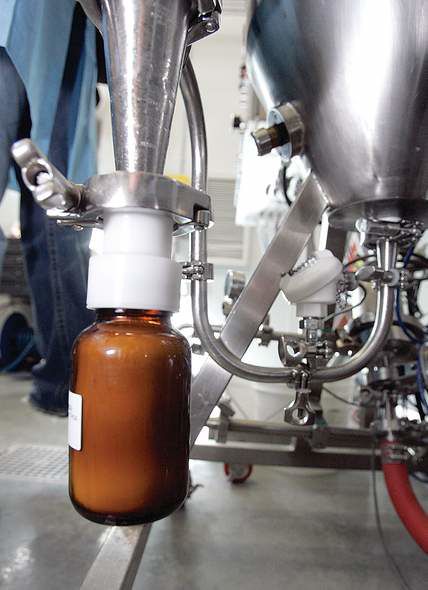Bend company gets key patent
Published 5:00 am Monday, September 6, 2010

- A variety of spray nozzles displayed Thursday are part of Bend Research’s patented spray-dried technology to make a new generation of drugs for treating cancer, heart disease, liver disease and immune diseases more water soluble, and more easily absorbed into the blood stream of patients taking oral medicines.
Plop plop, fizz fizz takes on a whole new meaning with the advanced spray-dried pill formulation patented by Bend Research to help patients digest a new generation of pharmaceuticals being developed for cancer, heart disease, liver disease and immune disorders.
After more than $100 million invested in research and development, Bend Research announced Aug. 30 it has patented a better, less expensive, more efficient process for creating drug formulations that are more easily dissolved in water and absorbed in patients’ digestive tracts, according to Jim Nightingale, vice president of applied technology at Bend Research.
Trending
“Drug companies have invested in it as well as we have put some money in it,” Nightingale said. “Bend Research is proud to be working on these medicines with leading researchers in the world, including the United States, Europe, Japan and China.”
Bend Research employs about 175 people in the Bend area, and Nightingale said the newly patented technology is already creating additional research jobs at the company’s Bend headquarters.
Several drug companies also approached Bend Research about adding a manufacturing facility to its operations in Bend, which Nightingale said could add 100 or more jobs if the company decides to step into the manufacturing arena, in conjunction with pharmaceutical companies.
Penciling out a local manufacturing facility
He said the company is working up a business plan to assess whether adding a manufacturing facility to produce drug formulations would pencil out.
Even without taking that step, however, Nightingale said Bend Research is growing.
Trending
“We are growing right now. We are currently hiring,” Nightingale said.
Cindy Cocanower, pharmacist and manager at the Bend Pill Box, said the ability to make drugs dissolve more easily in water and be better absorbed in the body could dramatically reduce the dosage of some antibiotics and other drugs due to improved bioavailability, or uptake into the bloodstream.
“We have quite a few drugs where you take 500 milligrams orally, but because of low bioavailability 400 milligrams comes out in feces and urine, and the other 100 milligrams actually get in the bloodstream,” Cocanower said.
She said the process patented by Bend Research could lower drug costs if the bioavailability is improved so that a higher percentage of the drug is absorbed into the blood.
In addition, Cocanower said the process also would make more drugs usable in treating patients in nursing homes or hospitals who are on feeding tubes.
In those cases, drugs are administered by crushing them, dissolving them in water and inserting them in liquid form into the feeding tube.
The spray-drying process patented by Bend Research is one of several technologies drug formulators can use to improve drug solubility, but Nightingale said more than 50 clients, including pharmaceutical companies, government agencies and university researchers are currently working with the company to test how Bend Research’s process works with a variety of drug compounds.
“What makes this patented process really useful is the fact that 30 to 40 percent, and possibly as much as 70 percent of the new chemical compounds being advanced by drug companies to create new medicines do not dissolve in water very well,” Nightingale said. “So, when you take it orally, it stays like a rock in your digestive system and goes out the other end.”
He said that “a lot of these compounds have been compared to brick dust — the medicines don’t dissolve. This technology makes them more easily dissolved in the stomach and intestine, so the medicine can be absorbed in the body.”
Combination of powders, solvent
To make the drugs more water soluble, scientists and lab technicians at Bend Research combine a drug powder and polymer powder with solvent. Nightingale said the drug and polymer are dissolved in the solvent, and the resulting solution is then sprayed into a dryer using a nozzle that creates droplets. When the solvent is removed through the spray-drying process, it leaves solid drug/polymer droplets that can be made into tablets that dissolve when taken orally by patients with a glass of water.
The patent describes an invention and process that creates the drug/polymer droplets using a pressure nozzle. Nightingale said the key to this process is it can be used to form large droplets that are easier to handle and process into tablets.
A news release last week from Bend Research says the patent addresses a common problem encountered using conventional spray-drying processes that often produce small droplets and particles that have poor flow characteristics, and are difficult to collect and formulate into solid forms needed to make tablets.
“This patent is an important addition to our spray-drying patent portfolio,” said Bend Research President and CEO Rod Ray. “Customers come to Bend Research for the quality of our science, engineering and clinical-supply manufacture, and our ability to move fast. Having patents that protect intellectual property offers them another key benefit by adding value to the formulations our scientists and engineers produce.”
The patent, titled “Method For Making Homogeneous Spray-Dried Solid Amorphous Drug Dispersions Using Pressure Nozzles,” was assigned Patent No. 7,780,988 by the U.S. Patent and Trademark Office.
Ray was among Bend Research inventors of the technology that also included Ron Beyerinck, Dan Dobry and Dana Settell.
Problem solvers
“In the industry, we are best known for solving difficult problems in how to deliver pharmaceuticals to the body orally,” Nightingale said.
Other technologies developed during the company’s 35 years include time-release drug formulations, like Z-Max, for example, where a pill taken once a day is released and absorbed into the body over time so dosing can be kept at a steady level with a single dose, as opposed to taking pills two, three or four times daily, Nightingale said.
“The technology we used makes sure not too much is released into the stomach at one time,” Nightingale said, adding that the time-released medications improve patient compliance with dosing instructions without releasing too much of a drug into the stomach at one time, which can cause a patient to vomit and expel the pill.








